SCS Curve Number Method and Its Application in HEC-HMS, XPSWMM, and InfoWorks ICM
SCS Curve Number (CN) method, proposed by USDA Soil Conservation Service (SCS, now known as NRCS), has been widely used for infiltration loss and runoff calculation due to its simplicity and history. The SCS Curve Number method includes a set of empirical equations and its core parameter is Curve Number, or CN, which is used to define maximum soil water retention/storage in terms of depth in inch (Figure 1).

Originally SCS Curve Number method was developed to calculate total runoff from total rainfall and over time it has been adapted to calculate infiltration loss and even runoff hydrograph (Figure 2). According to NEH Part 630 Chapter 10, the initial abstraction consists mainly of interception, infiltration during early parts of the storm, and surface depression storage. Unlike initial loss or depression storage of other infiltration method, the initial abstraction of SCS Curve Number method has a perpetual impact on infiltration and runoff flow rate calculation over the course of a simulation. Whenever it is possible, set initial loss or depression storage to zero for SCS Curve Number method and use initial abstraction instead; otherwise, using both a separate depression storage and initial abstraction will double account for the initial loss. For this reason, in the official EPA SWMM5 (not the commercial versions such as XPSWMM), the initial abstraction is coded as zero (0.0) and thus depression storage should be used.

The official published CN values can be looked up in NRCS NEH Part 630 Chapter 9 and TR-55 and as indicated in Figure 3 they were calculated by assuming average runoff condition (ARC=II) and initial abstraction of 0.2S. NEH Part 630 Chapter 10 states if a relationship different from Ia = 0.2S is used, a new set of curve numbers must be developed. For this reason, it is hard to justify using a different initial abstraction other than 0.2S unless curve numbers are to be re-calculated. NEH Part 630 Chapter 10 also provides a table to adjust curve numbers from average runoff conditions to antecedent dry (ARC=I)/wet (ARC=III) conditions (Figure 4A).

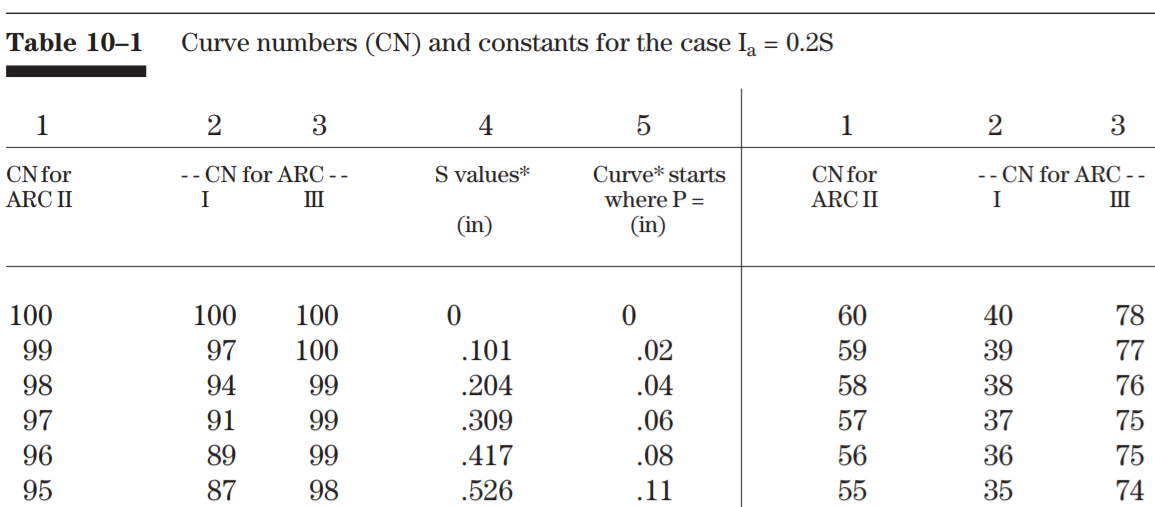
As illustrated in Figure 4B, a curve number should be determined by soil (Hydrologic Soil Groups, or HSG A, B, C, D) and land cover types (land use). Ras Mapper and GIS tools can be utilized to create a curve number raster file for calculating average curve number within a drainage basin or importing a gridded curve number dataset to a HEC-DSS file as explained in this post.
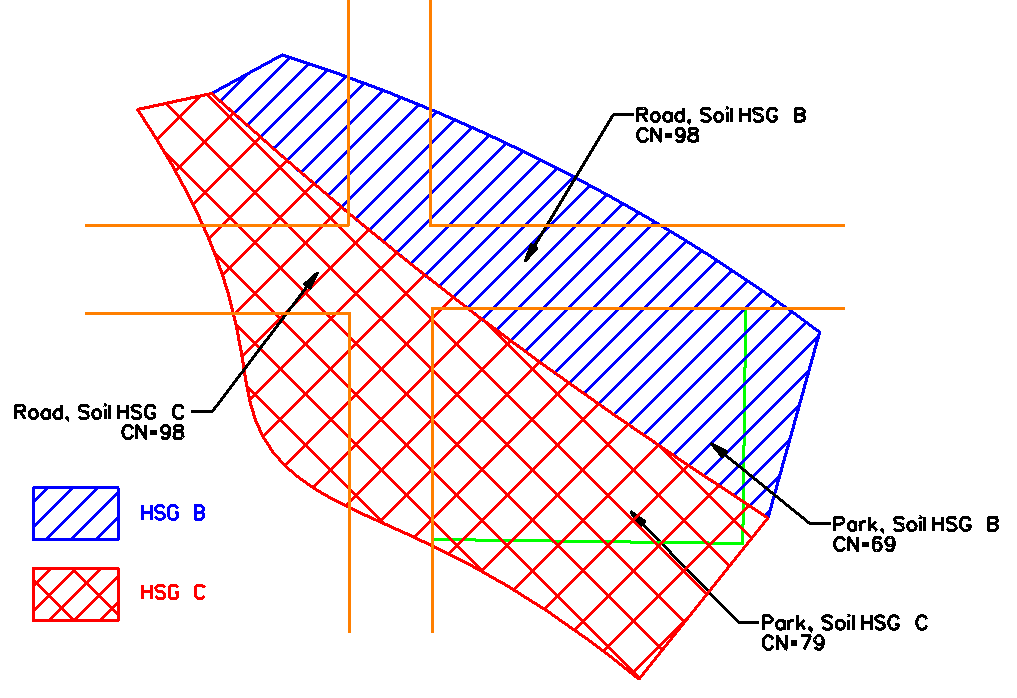
The peak discharge of SCS Curve Number method can be estimated using Graphical Peak Discharge Method introduced by the TR-55 Chapter 4 Equation 4-1 (Figure 4C). The unit peak discharge value is to be estimated from Exhibit 4-I, 4-IA, 4-II, and 4-III with known Time of Concentration (hours) and Ia/P.

The Graphical Peak Discharge Method has some limitations as explained in TR-55. For more complex watershed conditions, H&H software such as TR-20, HEC-HMS, XPSWMM, and HydroCAD should be utilized to calculate peak discharges and/or hydrographs.
SCS Curve Number method can be easily set up in HEC-HMS. The initial abstraction cell should be left blank unless a different relationship between Initial Abstraction and S is required. The curve number to be provided is either a composite value with Impervious (%) being set as zero (Figure 5A) or a value just for pervious surface but having a non zero Impervious (%).

For illustration, a HEC-HMS model result is shown in Figure 5B where the loss method is SCS Curve Number.
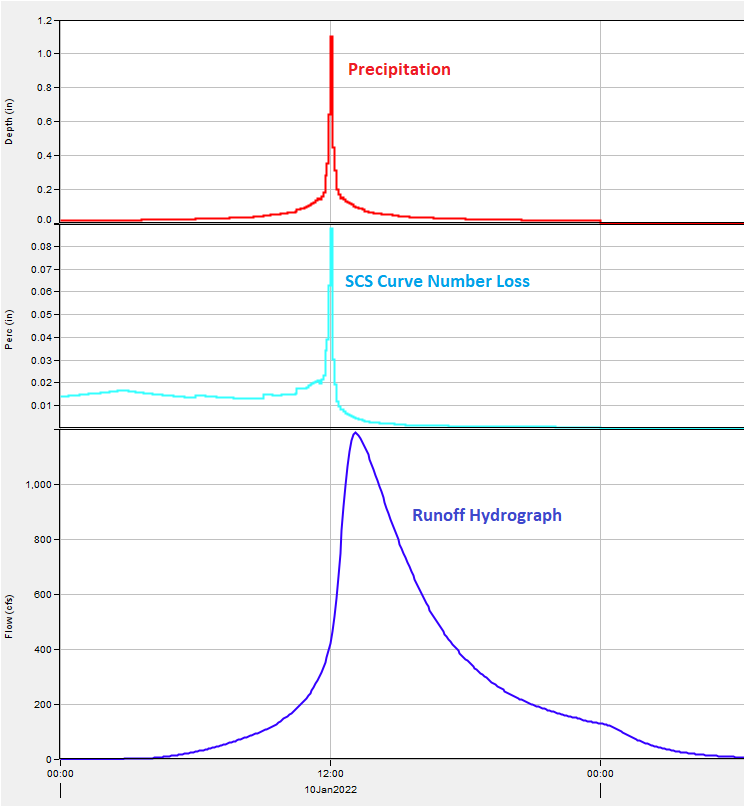
In XPSWMM, the SCS Curve Number method is defined as an infiltration method in Global Data (Figure 5C). After it is defined, it can be used by other hydrology routing (transform) methods such as Runoff (SWMM nonlinear reservoir routing) or Unit Hydrograph. However, when the hydrology routing or transform method is SCS Hydrology in XPSWMM, the previously defined SCS Curve Number is not to be utilized, instead, the SCS Hydrology method itself requires a CN (Figure 5D).
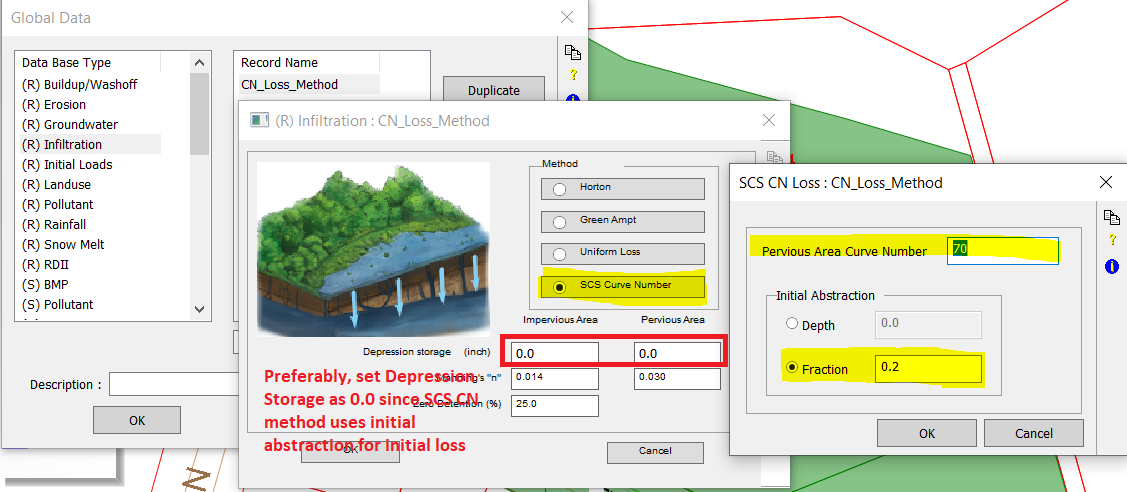
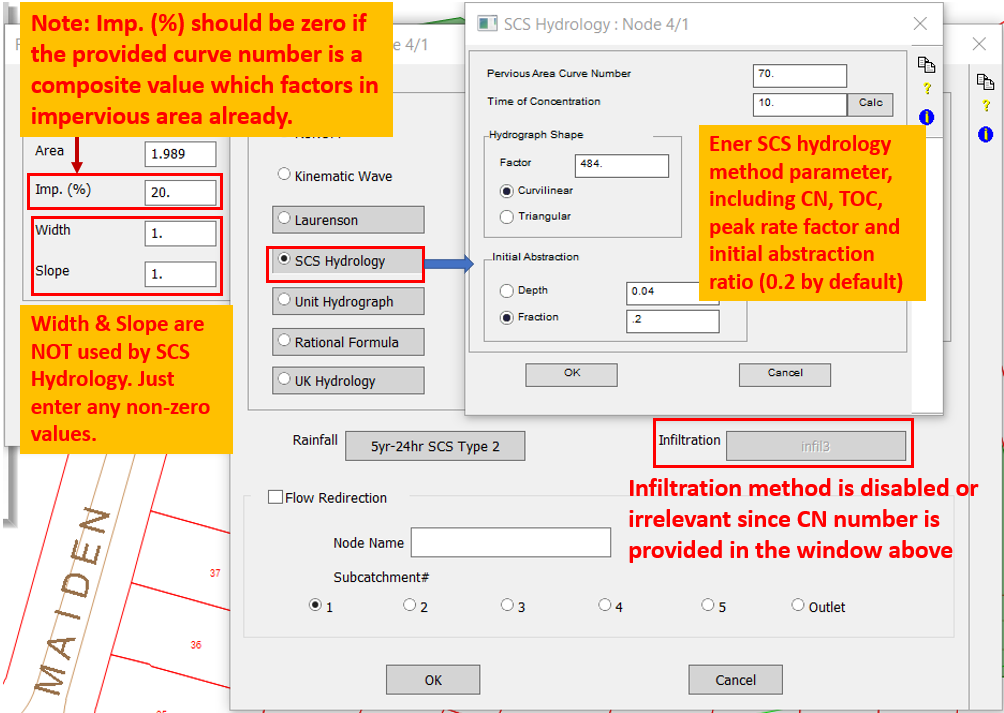
InfoWorks ICM has the capability to apply SCS Curve Number method as a runoff volume type to a subcatchment, however, its implementation is not as straightforward as SWMM or HEC-HMS. Before creating a subcatchment using SCS Curve Number method, it is beneficial to read through this post to have a general idea on how subcatchment hydrology works in InfoWorks.
These two terms are nearly interchangeable when dealing with infiltration loss methods: SCS method and CN method, however, in InfoWorks ICM CN method should be used if the intention is to repeat the traditional SCS Curve Number method (Figure 6). SCS method in InfoWorks ICM is a little bit different, which requires a user-defined storage depth as input.
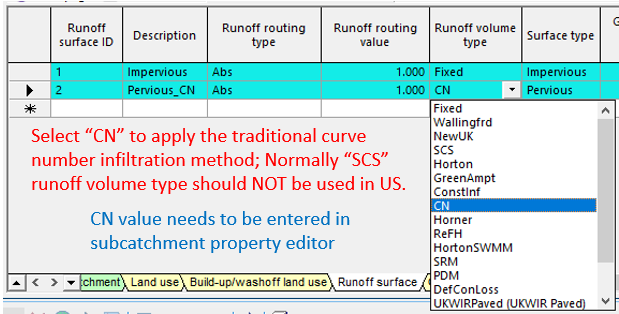
In addition to a pervious runoff surface with “CN” runoff volume type, an impervious surface can be created to represent DCIA area – Directly Connected Impervious Area which drains to storm sewer system/waterbody directly (Figure 7). Although it is preferable to define a separate impervious surface to better model subcatchment response from DCIA, it is NOT absolutely necessary; If an impervious surface is not defined, the pervious surface CN should be a composite value calculated by weighted pervious and impervious curve numbers.

Land use will need to be defined next. A land use in InfoWorks ICM basically is a combination of runoff surfaces with different percentages of areas. In Figure 8, two land use types are defined and Landuse_2 has more impervious area than Landuse_1 in terms of area percentages.

A sample subcatchment property editor is shown in Figure 9 where a curve number is to be entered. Various routing/transform methods can work together with CN runoff volume method. For the example in Figure 10, Clark UH is selected with TOC of 30min and storage coefficient (Lag time in InfoWorks ICM) of 60min.
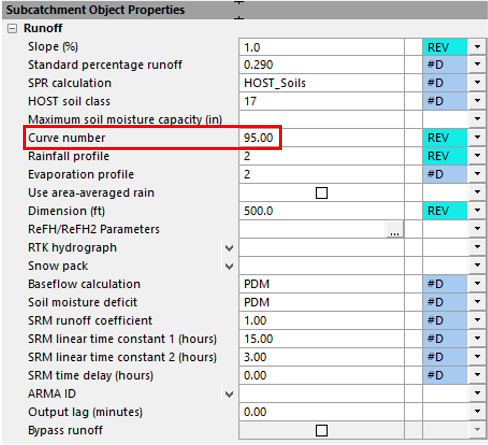
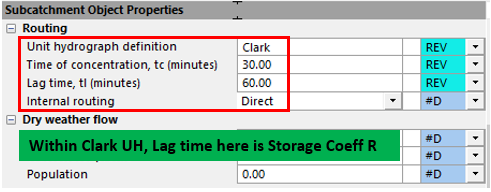
When using “CN” runoff volume type in InfoWorks ICM, the SCS index needs to be set as “2” in rainfall sub-event property editor and rainfall profile property editor. SCS index of 2 means average soil condition and the maximum soil water retention/storage S = 1000/CN-10 will not be adjusted, while SCS index of 1 or 3 means dry/wet condition and S will be multiplied by 2.281 (SCS index = 1) or 0.427 (SCS index = 3). Fortunately, the default values of SCS index have already been set as 2 (Figure 11) and 0 (Figure 12) by InfoWorks for average condition. Adjusting the maximum soil water retention/storage S by multiplying a factor to account for dry/wet conditions is strongly discouraged. Such adjustment, if absolutely needed, should be done by converting average condition Curve Numbers to corresponding dry/wet values in reference to NRCS NEH Part 630 Chapter 10 Table 10-1 as explained above.
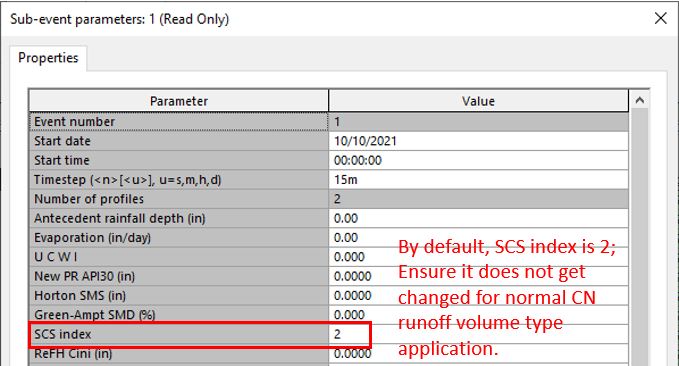
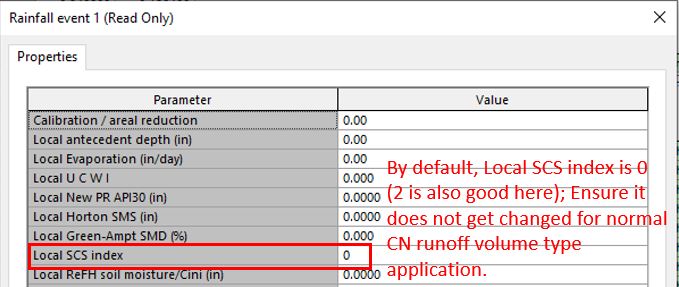
The runoff hydrographs from HEC-HMS and InfoWorks ICM model runs for an identical subcatchment are compared and they look close (Figure 13).
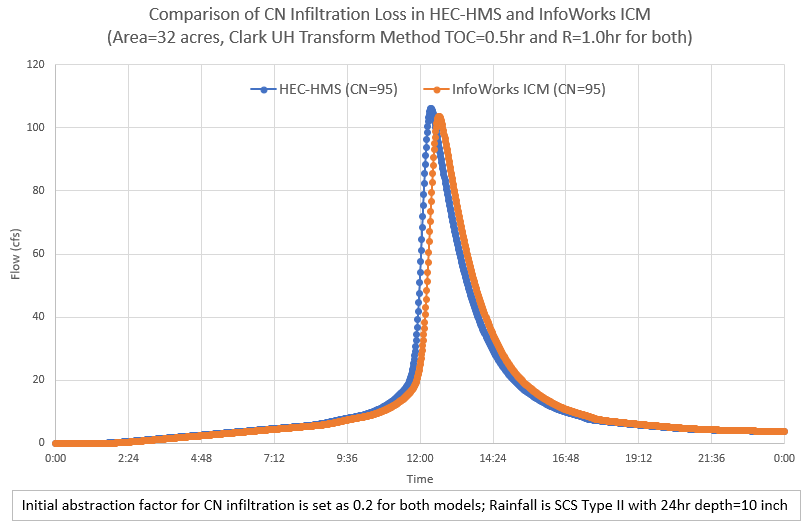
Leave a Reply